The Incredible Bishop Creek Story
Originally written in 1996
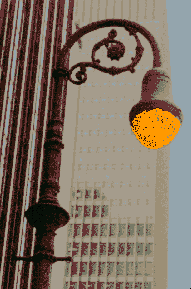 Once upon a time, in a lost New York City, that
existed until shortly after my birth, there was one name in streetlighting
for the vast majority of New Yorkers. Vast numbers of little,
unassuming candy-cane shaped Bishop Crook poles manned the endless
sea of intersections on NYC's side streets. They stood watch
in every borough. They coexisted peacefully with their long-masted
cousins, the Corvingtons. Neither of them begrudged the position
of their twin-lamped buddies, that often held court on the wider,
divided boulevards, like the Grand Concourse and Queens Blvd.
They did their job for well over half a century and over that
span of time they held innumerable incandescent fixtures. Once upon a time, in a lost New York City, that
existed until shortly after my birth, there was one name in streetlighting
for the vast majority of New Yorkers. Vast numbers of little,
unassuming candy-cane shaped Bishop Crook poles manned the endless
sea of intersections on NYC's side streets. They stood watch
in every borough. They coexisted peacefully with their long-masted
cousins, the Corvingtons. Neither of them begrudged the position
of their twin-lamped buddies, that often held court on the wider,
divided boulevards, like the Grand Concourse and Queens Blvd.
They did their job for well over half a century and over that
span of time they held innumerable incandescent fixtures. |
 Their fixtures had no choice but to point themselves
towards the ground, reflective of the down-to-earth focus of
the masses who lived within their shadows. These were years of
great struggle and hardship for many, with no mandated safety-net
to catch the poor or unemployed. Most New Yorkers were focused
on simple survival, keeping mouths fed and roofs over heads.
The most predominant fixture, from the 20's through the depression,
featured oversized acorn-shaped diffusers, whose light would
stick out from the fixture. Because this rendered the light visible
from the sky, these fixtures posed an air raid risk. The glass
bowls topsides had to be painted black to prevent light aiming
skyward. Their fixtures had no choice but to point themselves
towards the ground, reflective of the down-to-earth focus of
the masses who lived within their shadows. These were years of
great struggle and hardship for many, with no mandated safety-net
to catch the poor or unemployed. Most New Yorkers were focused
on simple survival, keeping mouths fed and roofs over heads.
The most predominant fixture, from the 20's through the depression,
featured oversized acorn-shaped diffusers, whose light would
stick out from the fixture. Because this rendered the light visible
from the sky, these fixtures posed an air raid risk. The glass
bowls topsides had to be painted black to prevent light aiming
skyward.It was perhaps with this concern in mind, that the bowls began to shrink on the new fixtures that emerged, in the 30's. |
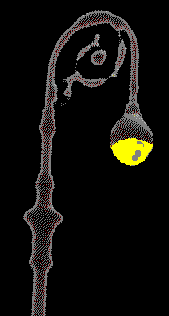 Perhaps the more subdued light and reduction
in glass of the newcomers, also reflected the mood of the depression
in which they were born. The diffuser bowl kept its place within
the confines of it's bulb holder's contours on the new Gumball
shaped fixture. The bell shaped fixture was not designed much
different than the acorn bowl's holder, but now looked totally
like a bell. The design focus now appeared to be on the fixture,
not the diffuser. The Bell's bowl was about the same size as
the Gumball's, but the overhanging bottom of the bell made it
clear that the bowl was neither superior, nor equal, in their
relationship. Perhaps the more subdued light and reduction
in glass of the newcomers, also reflected the mood of the depression
in which they were born. The diffuser bowl kept its place within
the confines of it's bulb holder's contours on the new Gumball
shaped fixture. The bell shaped fixture was not designed much
different than the acorn bowl's holder, but now looked totally
like a bell. The design focus now appeared to be on the fixture,
not the diffuser. The Bell's bowl was about the same size as
the Gumball's, but the overhanging bottom of the bell made it
clear that the bowl was neither superior, nor equal, in their
relationship.After WW II, both of these fixtures gave way to the cuplights. The cups did not arrive alone, however. Their companions wrote the handwriting on the wall, not only for the Bishops, but for all the cast iron poles. A new pole, austere and functional, emerged in the postwar years. |
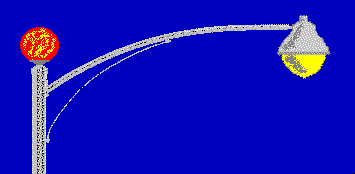 It was essentially an hexagonal shaped, upright
electrical conduit, paired at first with soft-curved, braced
masts, later with unbraced, crookarm masts. Wider roads would
get a longer, curved brace arm. The new poles took over developing
neighborhoods in the outer boroughs, on new streets and in place
of mast arms hung from telephone poles. It was essentially an hexagonal shaped, upright
electrical conduit, paired at first with soft-curved, braced
masts, later with unbraced, crookarm masts. Wider roads would
get a longer, curved brace arm. The new poles took over developing
neighborhoods in the outer boroughs, on new streets and in place
of mast arms hung from telephone poles. |
| In the 50's, the city began the wholesale removal of the cast irons. Though all the Bishop Crooks could hold the cuplights then in use, the city must've seen great savings in maintainance costs. Although the hex poles also needed painting, they did not have intricate ironwork for painters to labor over. Just swoosh the brush up and down their sides and they were done for years. There must've been an emotional rush to do away with the old as well. Modernity was in. The Bishops must've looked too European. Many cities there had variants of them. They were probably an unwelcome reminder of hard times and war. Maybe they were even suspected of being Communist. |
 Still, the Bishops and their casted cousins
might have survived longer if not for the arrival of the cuplight's
death knell. Still, the Bishops and their casted cousins
might have survived longer if not for the arrival of the cuplight's
death knell.The cups at least, could be fastened to the vertical coupling point on the Bishops. The new, horizontal, snake headed mercury fixtures, like the cheerful Westinghouse Silverliners, could only fit onto the new brace & crook arms. |
| In the early 60's, there were still uncountable Bishop Crook poles, at untold thousands of street corners, in every borough of NYC. Then came their final disaster. They were anihilated, along with the long-arm masted Corvingtons, and the twin-lamped 5th Avenue lamps, by the relentless 1960's invasion of the maniacal over-the-top Donald Deskey "Bigloop" and "Kojak" Quarterloop uplift masted standards. |
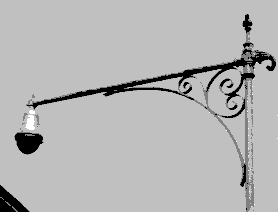 Why the Corvingtons couldn't be fitted with
the mercs is questionable. Indeed, snake headed fixtures could
be stuck at the end of the Corv's masts, but they probably would've
looked real stupid. They were designed with down-hanging lamps
in mind. Still, they were worth preserving if possible. Why the
many cuplights throughout the city's streets couldn't
be given mercury bulbs , to prolong the life of the poles
dependent on them, is a question only NYC's DOT can answer. Why the Corvingtons couldn't be fitted with
the mercs is questionable. Indeed, snake headed fixtures could
be stuck at the end of the Corv's masts, but they probably would've
looked real stupid. They were designed with down-hanging lamps
in mind. Still, they were worth preserving if possible. Why the
many cuplights throughout the city's streets couldn't
be given mercury bulbs , to prolong the life of the poles
dependent on them, is a question only NYC's DOT can answer. |
The bottom line is that the Corvs, Bishops and other cast irons probably needed more care than the uncaring city wished to keep giving them. I started to photograph the scattered remains of Manhattan's cast irons, in 1982, armed with a ridiculous 110 camera. There were still quite a few of them left in isolated spots.
The Battery Tunnel area was full of Corvs, still with their Bell lamps. In fact, almost all the caststers left at that time, still had their incandescent bell and cuplights. The Gumballs were utter history within the city, except for a little pole at the foot of the Manhattan Bridge, in Chinatown.
City Hall Park, and the surrounding area still had lots of Bishops, and even midtown, around Grand Central Station, had a few that the DOT missed. A number of these had Landmark plaques affixed to them, protecting them from future removal. How they survived until those plaques were placed on them, I don't know.
There's a saying, "what comes around goes around". The Bishops and their cousins had suffered so greatly in the 50's and 60's. They all but disappeared except for a few stragglers that sentimental DOT workers must've given reprieves to. Then something began to happen in the mid 80's.
I first noticed them in 1985, in Jackson Heights, Queens, in a busy shopping area. RECASTED BISHOPS, with new, sodium vapor Bell lamps. The retro craze had begun. In the decade that followed, the city began to earnestly attempt to recapture it's past. New castings of the Bishops and Corvs started popping up in touristy areas, major shopping strips and parkside roads.
The remaining originals were fitted with sodium bucket-shaped fixtures. Why they couldn't get the same sodium bells that the new castings got, is yet another mystery that only the DOT can solve. A few originals did get new bells, most got bucketed. As I write this, 6th Avenue has been totally taken over by Bishops. Columbus Avenue, by jolly green Corvs.
The retro craze also resulted in some retro horrors. Apparently, attempts were made to avoid replicating the old styles, by planting new designs that combined both the modern look and the ancient.
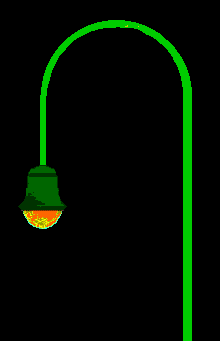 This resulted in the most hideous lampposts
ever seen on earth. Both Flatbush Ave, in Brooklyn and 8th Ave.
in Manhattan, got these awful, green colored, nightmarish pseudo-Corvingtons.
The best, however, was saved for one of the DOT's greatest blunders,
the massive 14th St. rebuilding project. Beset by constant delays
and do-overs, this unfortunate street suffered the indignity
of getting giant, looping, green snake-like, unadorned Pseudo-Bishops,
with new sodiumized Bells, that kept burning out because they
were wired wrong. Today, I can only laugh at them. I'm sure that
their sheer uglyness will endear them to the city, assuring them
of being embraced down the road. This resulted in the most hideous lampposts
ever seen on earth. Both Flatbush Ave, in Brooklyn and 8th Ave.
in Manhattan, got these awful, green colored, nightmarish pseudo-Corvingtons.
The best, however, was saved for one of the DOT's greatest blunders,
the massive 14th St. rebuilding project. Beset by constant delays
and do-overs, this unfortunate street suffered the indignity
of getting giant, looping, green snake-like, unadorned Pseudo-Bishops,
with new sodiumized Bells, that kept burning out because they
were wired wrong. Today, I can only laugh at them. I'm sure that
their sheer uglyness will endear them to the city, assuring them
of being embraced down the road.Another rebuild project, on Eastern Parkway in Brooklyn, got more dignified knockoffs of the Corvingtons. The city had apparently learned it's lesson on knockoffs. Subsequent retro plantings have stuck to the original designs. |
The money that is getting spent on these, must be astronomical, just as the expense must've been when the originals were being replaced. Is the next century going to witness Retro Bigloops?
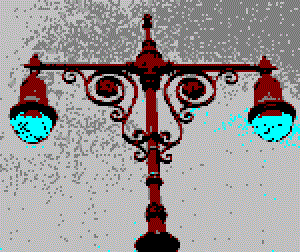
|
The Eastern Parkway project, as well as an ongoing lamp replacement in the 34th Street area of Manhattan, feature another retro trend. Their fixtures are white light (mercury vapor or halide), instead of sodium. The retro 5th Avenue Twinlamp poles, lining the main library at 42nd Street, are also white light. Can an incandescent comeback be far behind? |
